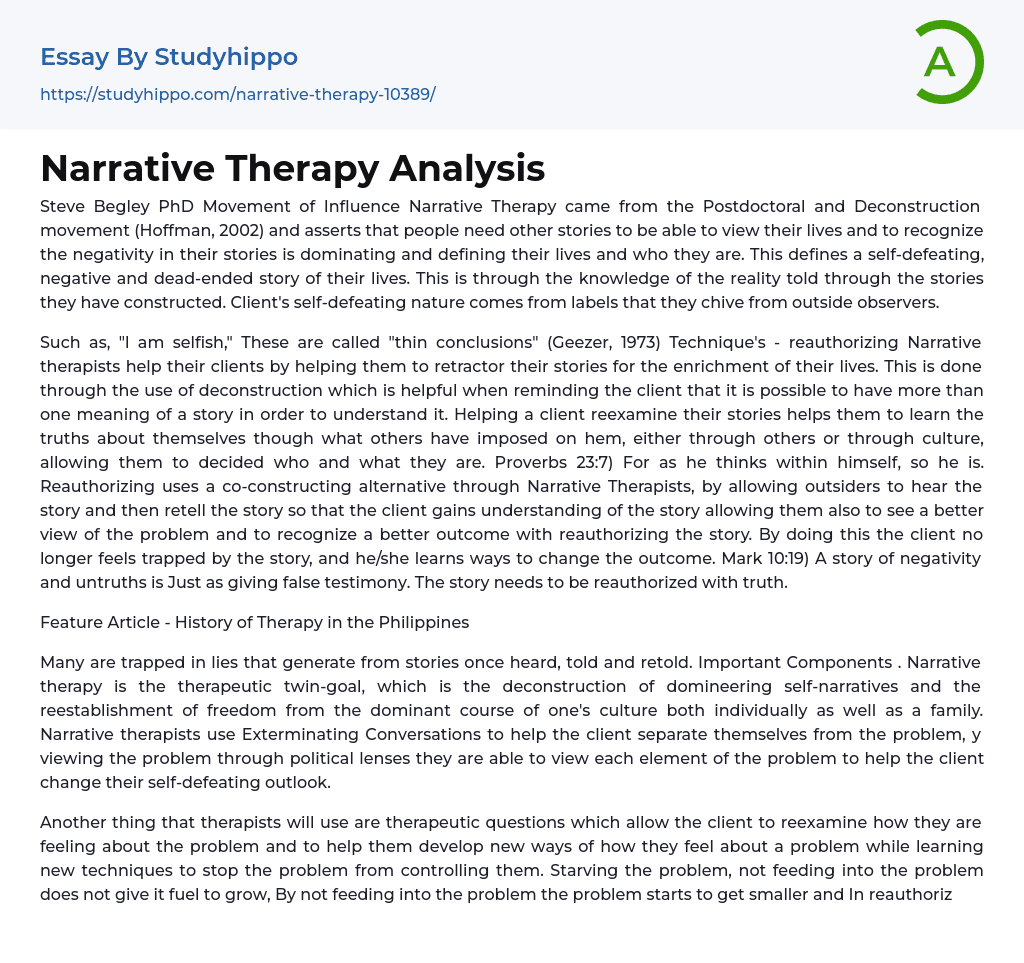Movement of Influence
Narrative Therapy came from the Postdoctoral and Deconstruction movement (Hoffman, 2002) and asserts that people need other stories to be able to view their lives and to recognize the negativity in their stories is dominating and defining their lives and who they are. This defines a self-defeating, negative and dead-ended story of their lives. This is through the knowledge of the reality told through the stories they have constructed. Client's self-defeating nature comes from labels that they chive from outside observers.
Such as, "l am selfish," These are called "thin conclusions" (Geezer, 1973) Technique's - reauthorizing Narrative therapists help their clients by helping them to retractor their stories for the enrichment of their lives. This is done through the use of deconstruction whi
...ch is helpful when reminding the client that it is possible to have more than one meaning of a story in order to understand it.
Helping a client reexamine their stories helps them to learn the truths about themselves though what others have imposed on hem, either through others or through culture, allowing them to decided who and what they are. Proverbs 23:7) For as he thinks within himself, so he is. Reauthorizing uses a co-constructing alternative through Narrative Therapists, by allowing outsiders to hear the story and then retell the story so that the client gains understanding of the story allowing them also to see a better view of the problem and to recognize a better outcome with reauthorizing the story. By doing this the client no longer feels trapped by the story, and he/she learns ways to change the outcome. Mark 10:19) A story of negativity and
untruths is Just as giving false testimony. The story needs to be reauthorized with truth.
Feature Article - History of Therapy in the Philippines
Many are trapped in lies that generate from stories once heard, told and retold. Important Components . Narrative therapy is the therapeutic twin-goal, which is the deconstruction of domineering self-narratives and the reestablishment of freedom from the dominant course of one's culture both individually as well as a family. Narrative therapists use Exterminating Conversations to help the client separate themselves from the problem, y viewing the problem through political lenses they are able to view each element of the problem to help the client change their self-defeating outlook.
Another thing that therapists will use are therapeutic questions which allow the client to reexamine how they are feeling about the problem and to help them develop new ways of how they feel about a problem while learning new techniques to stop the problem from controlling them. Starving the problem, not feeding into the problem does not give it fuel to grow, By not feeding into the problem the problem starts to get smaller and In reauthorizing a story with negative elements, it would be wise to focus on the elements that could be turned into positives.
- Asking questions like; when, did they start feeling depressed?
- Or have they ever experienced the feelings before?
- When was the last time they felt happy?
I would also have them recall what they did before to get through their feelings of depression by asking, You got through the depression before, what did you do different then to make you feel better? Giving them room to reexamine
their feelings and the problem that led them to feel as they do, would give hem the opportunity to realize they do not have to own those feelings.
It is the client who can change how they choose to feel about a particular problem. The fact that the stories one develops helps in defining who they are makes sense. When a child is brought up hearing a story about them whether it is negative or positive, it ingrains itself into the child. The child then believes it, and when it is negative they never know about the positive so they believe only the negative things about their lives.
Reference:
- Goldenberg, H and Goldenberg, I (2013) Family Therapy Overview (e) Brooks/Cole Coinage Learning
- Anatomy and Physiology essays
- Addiction essays
- Biodegradation essays
- Dental Care essays
- Disease essays
- Disorders essays
- Health Care essays
- Intelligence Quotient essays
- Nutrition essays
- Olfaction essays
- Public Health essays
- Women's Health essays
- World health organization essays
- Cancer essays
- Infectious Disease essays
- Lung Cancer essays
- Neurology essays
- Physical Exercise essays
- Medicine essays
- Sex essays
- Inquiry essays
- Disability essays
- Poison essays
- Action Potential essays
- Nervous System essays
- Childbirth essays
- Puberty essays
- Blood essays
- Kidney essays
- Neuron essays
- Body essays
- Glucose essays
- Sense essays
- Heart essays
- Skeleton essays
- Human Physiology essays
- Eye essays
- Immune System essays
- Muscle essays
- Skin essays
- Brain essays
- Central Nervous System essays
- Human Skin Color essays
- Digestive System essays
- Common sense essays
- Respiration essays
- alcoholism essays
- Smoking essays
- Casino essays
- Tobacco essays




